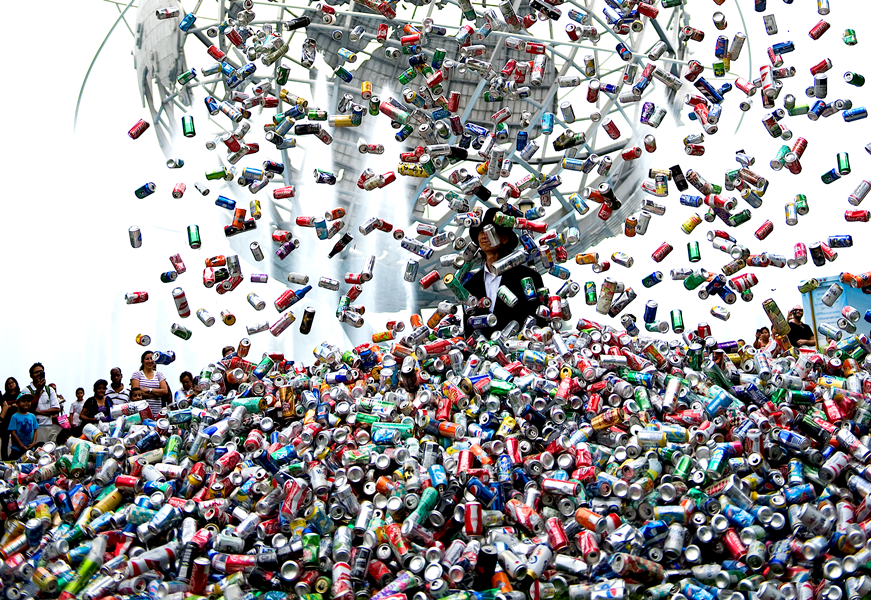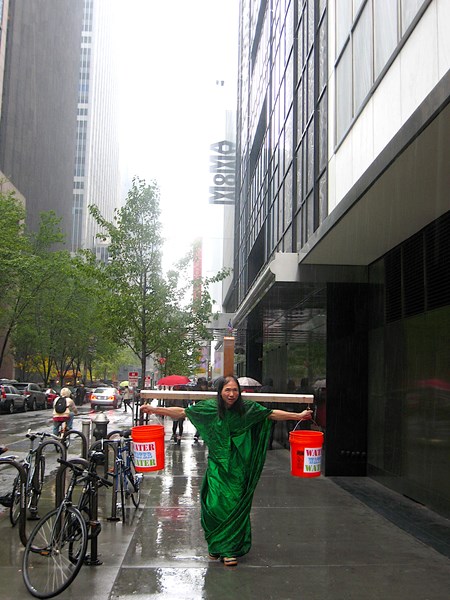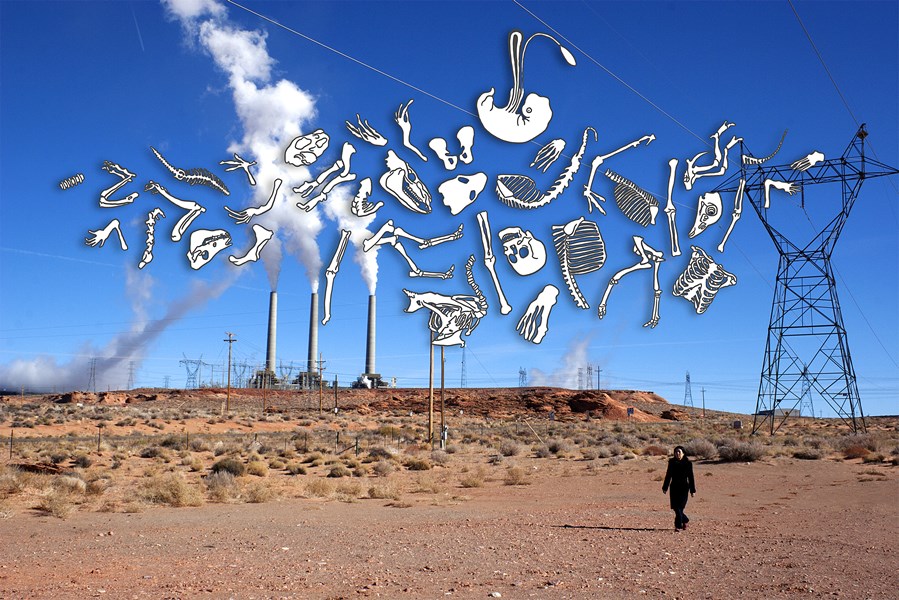Climate Artists: Disruptors of the Peace
Jan 09, 2019
 By Nancy Rakoczy, approved candidate for ordination in the MNYS
By Nancy Rakoczy, approved candidate for ordination in the MNYS
In their relentless pursuit of profits and self-interest, corporations and governments have set aside values, which reflect the common good, and have instead put our world on a path to collective self-destruction. Passive acquiescence on the part of the citizenry has unwittingly formed a partnership in this destruction, which has brought us to this present global crisis of climate change. Climate artists have emerged as a new category of citizen activists who do not just question the status quo, as established by these elites, but work to disrupt it. These artists are disrupters of a fraudulent peace created from consumerism and materialism, which has attempted to diminish humanity and has succeeded in poisoning and despoiling our earth.
Under discussion are, Liberate Tate of London, England, Eve S. Mosher’s HighWaterLine (2005); Sarah Cameron Sunde’s 36.5 A Durational Performance with the Sea (2013); Chin Chih Yang’s, Kill Me or Change (2012); and the 2015 interventions of the New York arts collective, The Illuminator. All of these artist-instigators, by combining arts with activism, have worked to alert, and confront passivity or collusion in order to bring attention to and slow climate change.

Kill Me or Change" by Chin Chih Yang
Photographie by Rodrigo Salazar
"Chin Chih Yang's project was to collect 35,000 empty soda cans and release them on top of him. Part of the tension of the project was to see if he would survive. The point of the project was to draw attention to our society that wastes.
Which artist could be considered “Disrupter-in-Chief”? Certainly, the collective, Liberate Tate, of London, England, which began working in 2010, is a prime example of the artist/provocateur/disrupter of the peace. Their actions combined aesthetics, ritual, performance, subversive humor, and pathos in a variety of works that spanned six years. Virtually unknown in this country, their mission was to get British Petroleum to drop their financial sponsorship of the Tate Museum in London, as it gave the oil company respectability, “a social license to operate,” despite its role in despoiling and depleting the earth.[1] Liberate Tate worked to help us visualize what they called the “End of the Oil Age.”[2] Says Kevin Smith a long-time member, Liberate Tate’s mission was “to ramp up the stigmatization of oil companies as soon as possible in order to diminish the political, financial, and cultural power that they have over society.”[3]

Carry Water by Chin Chih Yang
Photographie by Rodrigo Salazar
Chin Chih Yang's project was to carry water from the Museum of Modern Art to the Met Museum, walking along Fifth Avenue.
You can find out more by contacting him at [email protected].
License to Spill (2010) was a performance created for the 20th anniversary of BPs sponsorship with the Tate Museum.[4] Female members of the collective attended the gala party; underneath their petticoats, were hidden containers of a dark, oily substance. While munching on appetizers and sipping wine with the other attendees, at a signal, the women released the sticky, gooey substance, from beneath their dresses. This residue upon the floors of the Tate was a visceral reminder of the disastrous effect oil spills have had upon the oceans and wildernesses, and BPs responsibility in the matter.
Their work, Human Cost (2011) involved the performance of a funereal ritual in which two members of the collective robed and veiled in black, solemnly and silently poured a black oily substance upon the prone and naked form of a third member in the Tate’s gallery.[5] This was an eerie reenactment of vulnerable and dying wildlife, which marked the first anniversary of the Deep Water Horizon’s oil spill in the Gulf of Mexico, which has proved disastrous for the wildlife of the area for many years.
In The Gift, (2012) the collective again used performance to present the Tate with a 1300 kilo, sixteen and a half meters long, one point three ton wind turbine blade of a wind generator, to provoke them into rethinking their relationship with BP.[6] “The Museum and Galleries Act stated that if you gave a gift to a national institution, it has to consider it a part of its collection.”[7] About fifty members of the collective were needed to slowly and silently bring the pieces of the gargantuan propeller into the Museum where it was laid down gently on the floor of the gallery. A giant wind turbine blade proved to be not what the Tate desired for their collection, and ultimately declined The Gift.

Desert Power Plant in the Sacred Land by Yoon Cho (2011-16)
Photographie by Yoon Cho
Whereas Liberate Tate focused and challenged the behemoth corporate entity, Chin Chih Yang’s scope was smaller and human-sized. He has been called the “Taiwanese Charlie Chaplin” for performances that combined danger, humor, pathos, and activism upon behalf of the earth[8] For “Kill Me or Change,” (2012) at the Queens Museum of Art, in Flushing, New York, Yang zeroed in on the responsibility of the individual to the planet. He had collected 30,000 empty soda cans and placed them in a net directly above his head.[9] These cans represented a lifetime consumption of soda, and he collected them as a way to bear witness to our habits of thoughtless consumerism, and beg the question, ‘Where do 30,000 cans go when we’re finished with them?’ With an ambulance parked nearby, the cans were released over the motionless Yang, burying him almost to the neck.
As victim/provocateur, Yang’s performance of genuine danger underscored the dangers of overconsumption. It is literally killing us.
Whereas Yang focused on bearing witness and confronting consumerism, Sarah Cameron Sunde’s project, 36.5 A Durational Performance with the Sea (2013) was equally confrontational, but of a more muted and meditative character. Both artists used human scale as its unit of measurement, in order to provoke awe, wonder, dismay and regret, as Yang evoked the vulnerability of the individual standing before the tides of our own detritus, and Sunde stood before the unstoppable tides and forces of nature.
For twelve hours, the length of a change in tide, and wearing a bright red wet suit, Sunde’s performances consisted of standing motionless in tidal pools. These performances were a witness to the mutual fragility and strength of humans and nature, our interconnectedness and our interdependence. Her work quietly asked us to remember our size, reconsider our relationship to the planet, and reconnect with nature and be its steward.
Watching the performance on a four-channel video installation was a meditative act in itself, and one saw fully clothed individuals who joined Sunde to stand motionless as the tides slowly rose to their chests, and receded[10]. She plans to create an opportunity in 2020 for New York City to participate in a new work of standing in tidal pools, as a way to draw attention to our mutual fragility in the face of relentless tides unleashed by global warming.
As disruptors of the peace, climate artists may also be prophetic, in order to shake the populace out of their torpor to the danger that surrounded and threatened to engulf them. In 2007, Eve S. Mosher grabbed a “Big Boy,” a two-wheeled device that highway maintenance crews used to make lines on the streets, and drew a seventy-mile long, continuous three-inch blue line upon streets and sidewalks, of Manhattan and Brooklyn. This was HighWaterLine, her seminal project that woke the city and neighborhoods to the fact of imminent severe flooding; she blue-lined areas that would be ‘wet’ or ‘dry’ come a flood due to climate change.
The line itself was stark, spare, minimal, and performative, as Mosher drew along the coast, to indicate a 10 feet line above sea level where flooding would most probably occur.[11] Of the blue line Mosher said: “It helps people to visualize climate change. It helps localize it.”[12] Seeing the line made the crisis of global warming tangible as if it were already lapping at their literal doorstep, and served to help citizens agitate for change. Notably, HighWaterLine was eerily prescient, coming five years before Super Storm Sandy inundated the low-lying coastlines of New York City.
Mosher has taken her blue line to other communities along the Eastern seaboard so that they too can agitate for change and prepare themselves for the worst.
Like Britain’s Liberate Tate, the New York arts collective, The Illuminator, also combined art with activism to confront arts institutions of their complicity with big oil and global warming. Both collectives have worked to do more than just rattle corporations, but have worked to dismantle their collusion with the institutions. The Illuminator’s mission is disruption. “Interventions disrupt the everyday flow of things. Encounters with the unexpected make people more aware of their presence with others and their influence over environments. This awareness bolsters their capacity to reinvent the world around them.”[13]
The Illuminator has zeroed in on the multi-billionaire Koch brothers, and used high powered projectors, to project the texts, “Koch = Climate Chaos,” and “The Met is a museum, not an oil lobby,” onto the Metropolitan Museum of Art’s facade to draw attention to their partnerships with big oil sponsorship. These illuminated interventions have highlighted the role of the Koch brothers as climate change deniers, along with their gift of sixty-five million dollars to the Met.
Like Yang, the Illuminator used performance and spectacle as their medium of expression. “Spectacle can be an important change-maker. It’s an artful intervention . . . It’s a way to shape public space.”[14]
The collective has also made available detailed instructions on their website so anyone can become an artful, illuminated interventionist.
Liberate Tate, Yang, Sunde, Mosher, and The Illuminator, have created climate art that has pointed to the hubris that is at work on our planet. These artists used their creativity, imagination and audacity to challenge systems, which degraded the earth. Their use of the unit of human scale, has underlined our mutual vulnerability and our collective fate in this crisis. They insist that attention must be paid or be overwhelmed by forces that we have thoughtlessly unleashed. Human caused global warming is an ongoing disaster, and these climate artists have sounded the alarm using spectacles and performances.
----------
Bibliography
Yang, Chin Chih. Kill Me or Change, Performance by Artist Chin Chih Yang at the Queens Museum of Art. July 28-29, 2012.
vimeo.com/46775357.
[7] The Gift: Documentary, Nov. 18, 2014, Accessed 12 Mar. 2018,
[9] Kill Me or Change, Performance by Artist Chin Chih Yang at the Queens Museum of Art, July 28-29, 2012
[12] Ibid.
[13] Ibid.